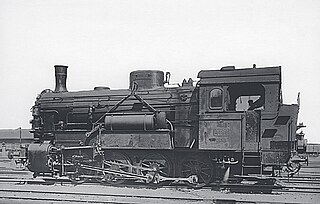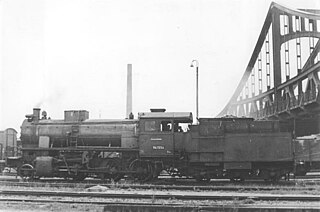
The Class S 3/6 steam locomotives of the Royal Bavarian State Railways were express train locomotives with a 4-6-2 Pacific or 2'C1' wheel arrangement.

The two-cylinder, superheated Bavarian Pt 2/3 engine was built by Krauss for the Royal Bavarian State Railways between 1909 and 1915. With its characteristic design - a carrying axle placed well to the front and two coupled axles at the rear under the outer firebox they asserted themselves over the rival Bavarian Pt 2/4 N and H classes and, after the demand fell for the services for which they were originally designed, they continued to be operated well into the 1960s on south German branch lines.
The steam engines of Class G 4/5 H operated by the Royal Bavarian State Railways were the most powerful of the German, 2-8-0, freight locomotives.

The Bavarian Class D XII steam locomotives were manufactured by the firm of Krauss from 1897 for the Royal Bavarian State Railways. Ninety six of them were procured for service on the stub lines running from Munich into the mountains, but in reality they were stationed in many large Bavarian locomotive depots. Two engines were transferred to the Palatinate Railway (Pfalzbahn) in 1916, the remaining 94 later joined the Deutsche Reichsbahn fleet and were incorporated as DRG Class 73.0-1 with operating numbers 73 031–124.
The Bavarian Class Pt 2/5 H locomotive of the Royal Bavarian State Railways was built by Krauss for the Nuremberg Trade Fair in 1906. Because this locomotive could no longer fully meet the performance requirements at that time, it remained a one-off. It was nevertheless taken over by the Reichsbahn and retired in 1933. The loco had a superheated steam system.
The Pt 2/4 H was a class of steam locomotive built by the firm of Krauss for the Royal Bavarian State Railways between 1906 and 1908. They were used on routes in Bavaria to haul light, fast passenger trains.
The Bavarian Pt 2/4 N was a steam locomotive with the Royal Bavarian State Railways. It was developed in parallel with the Bavarian Pt 2/3 and for the same duties. Instead of a fixed carrying axle it was given a bogie. This change brought no advantage, so the more cost-effective Pt 2/3 was favoured. The two Pt 2/4 N engines were nevertheless taken over by the Reichsbahn, but were retired by 1928.
The D IX steam locomotive was manufactured by the firm of Maffei between 1888 and 1899 for the Royal Bavarian State Railways. They were used on the route from Reichenhall via Freilassing to Salzburg. After one engine had been successfully employed on the route to Berchtesgaden, the vehicles were also deployed on the suburban lines of Augsburg, Munich and Nuremberg.
The 10 examples of the Class D V steam engine belonging the Royal Bavarian State Railways were the first six-coupled tank locomotives in Bavaria. They were intended specifically for working the hilly route between Plattling and Eisenstein. Because they did not deliver the expected performance, however, they were soon relegated to shunting duties.
The little D IV was one of the most frequently seen tank locomotives in the stations of the Royal Bavarian State Railways. The Deutsche Reichsbahn took over almost all of them, 124 in total, of which 24 were from the Palatinate (Pfalz).
The newer Class D II engines of the Royal Bavarian State Railways were goods train tank locomotives. The designation 'D II' was given to these locomotives only after all the older Class D II engines had been mustered out. Of the 73 engines that were built, 70 entered the Deutsche Reichsbahn as Class 89.6; the remaining 3 transferred to the Polish State Railways (PKP) in 1919 as Class TKh101. The majority were still working even after the Second World War. The last one was not taken out of service until 1960.
Class D I of the Royal Bavarian State Railways was a tank locomotive with two coupled axles designed for shunting. As had been specified, these locomotives were simple and robust. They had a double-frame, with water tanks being suspended between the sole bars of the front section. Because the water capacity of 1.74 m3 soon proved too little even for a shunter operating only within the limits of its own station, additional side tanks were added to some engines during the 1880s. The outside Stephenson valve gear moved the valves on top of the horizontal cylinders. The locomotives could be braked using an Exter counterweight brake.

The physically identical Palatine and Bavarian Class R 4/4 engines of the Royal Bavarian State Railways were goods train tank locomotives with four coupled axles and no carrying axles. The first nine machines were built for the Palatinate Railway (Pfalzbahn) in 1913 and 1915 as the Palatine Class R 4, the remainder from 1918 to 1925 as Bavarian R 4/4 engines.

The six-coupled P 5 of the Palatinate Railway (Pfalzbahn) was to replace the four-coupled locomotives in the Palatinate. They were given a leading Krauss-Helmholtz bogie and a trailing bogie in order to achieve satisfactory weight distribution.

The Bavarian G 5/5 goods train, steam locomotives were intended for steep stretches of line belonging to the Royal Bavarian State Railways network in northern Bavaria. The extremely sharp rise in the levels of traffic on these lines in the years leading up to the First World War meant that the eight-coupled Bavarian E I and G 4/5 N classes previously employed there were increasingly unable to cope.
The Bavarian Class G 4/5 N was an early twentieth century German 2-8-0 steam locomotive built for the Royal Bavarian State Railways (K.Bay.Sts.B.). Its design was based on that of the Class E I and it had unmistakable similarities to the final series of that class. Had the K.Bay.Sts.B. not changed their locomotive classification system just before this engine was produced it may well have entered service as the latest variant of E I.

The Class G 3/4 H was a steam locomotive of the Royal Bavarian State Railways built between 1919 and 1923.

The goods train locomotives of Class C VI were German steam engines built between 1899 and 1905 for the Royal Bavarian State Railways. It had great similarity to the Prussian G 5.4, but had a higher boiler overpressure and better riding qualities. In all the Bavarian state railways procured 83 engines of this type over that period. More machines with slight modifications were acquired between 1907 and 1909. These 37 engines were given the designation G 3/4 N. The Deutsche Reichsbahn inherited 64 Class C VI and 32 Class G 3/4 N engines. These were given operating numbers 54 1301–1364 and 54 1401–1432. The Class C VII locomotives remained in service until 1931, their Class G 3/4 N sister locomotives until 1935.

The C IV was a steam locomotive, built for goods train duties, that was manufactured between 1884 and 1897 for the Royal Bavarian State Railways.
The Bavarian C III engines were steam locomotives of the Royal Bavarian State Railways.








